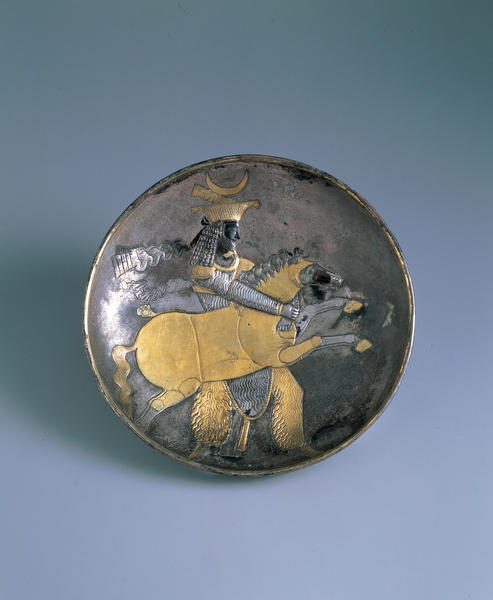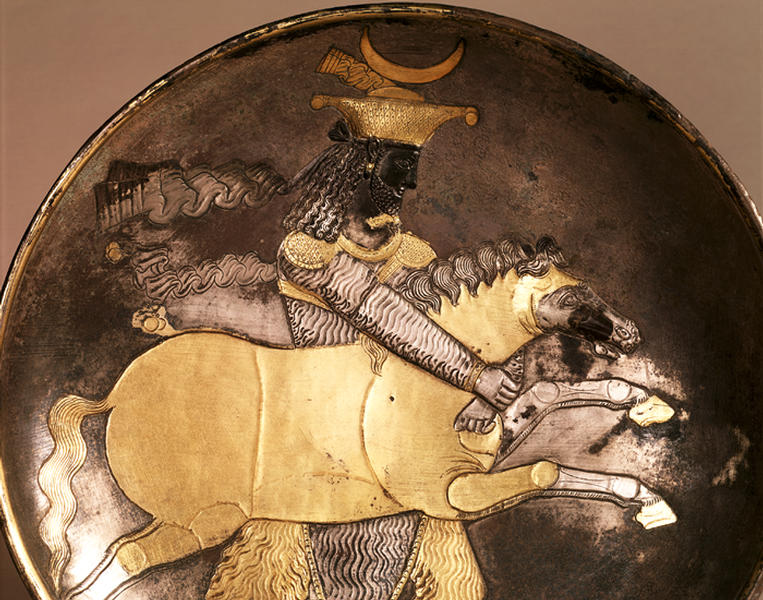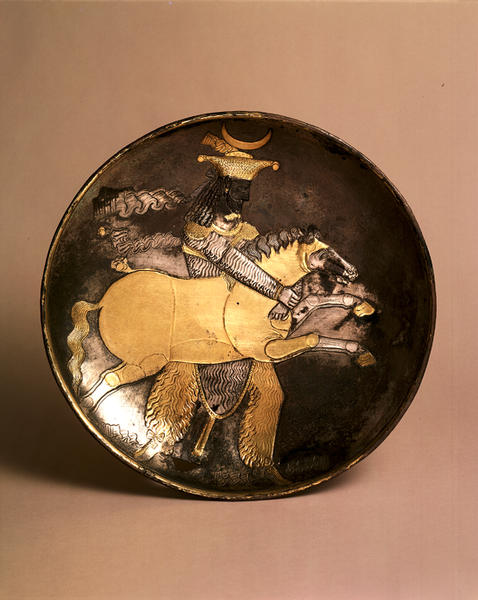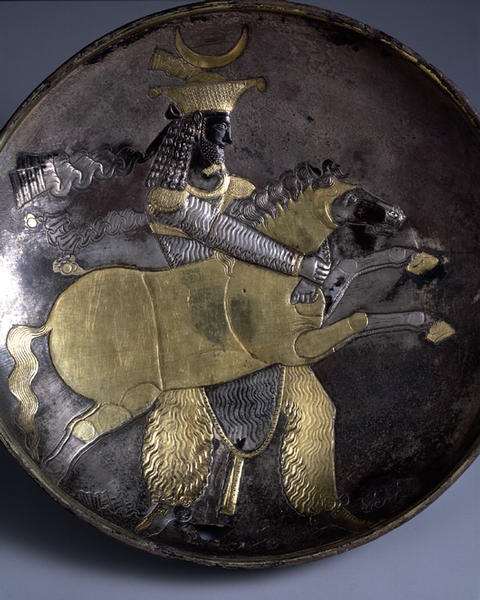王子と仔馬図大皿
- イラン
- ササン朝ペルシャ
- 4-5c
- 鍍金銀
- D-30
解説(開館1周年記念展)
この堂々たる大型の銀製皿の中央には,器の天地に達する人物が両足を踏ん張り,1頭の仔馬の首を両腕で捉えている。頭部の冠飾は,広がった上部の中央に半球形の隆起となびくリボンそして三日月形が付けられている。その冠の下から波打つ髪が後頭部に垂れる。後頭部と背中からなびくリボン,ビーズ状の耳飾,顎の先で括られたひげ,丸い肩あて,連珠文の襟飾と肩から胸にかけて施された帯状の装飾,波打つ薄地のパンタロンもしくは脚絆,リボンの装飾のある靴などは典型的なササン朝銀器の意匠である。両足の間から刀の鞘がのぞいていることと,ササン朝のコインの王の冠には見られない形態の冠から判断して,この人物は王を表したのではなく,むしろ王子もしくは首長を表したものと考えられる。
これに対し,仔馬の脚の関節や筋肉の表現は典型的なものであるとしても,刈り揃えられていない乱れるがままのたてがみ,括られていない尻尾,そして何よりも裸馬であるという表現は,今のところ類例を見ない。
この主題は伝説の英雄になぞらえた王子あるいは首長が仔馬を捉える場面であると思われるが,多くのササン朝銀器に表された王侯狩猟図とは大きく異なる。ササン朝時代から編纂されたと言われるイラン民族の神話,伝説などは,現在はほとんど失われ,イスラム期の民族意識の高まった10世紀頃に著された『王書』,その他の断片からかつての物語を窺い知る他はない。その中で,大男の民族的英雄ロスタムと将来の愛馬ラクシュとの出会いの物語が見られるが,*1 おそらくこの種の物語のもととなった古い伝説にもとづき,ササン朝時代にこのような銀器が作り出されたことが想像される。
英雄の右上腕と肘から下の部分,および馬の頭部にやや厚めに浮彫された断片が嵌め込まれているが,*2 この技法はササン朝の比較的早期のものとされている。なびくリボンや脚絆を立体的かつ柔らかい風合いをもたせて作り出している作行きは,北イラン・サリ由来の4世紀のものとされる,ほぼ同大の狩猟文大皿に通じるものがあるが,これは当時のイラン東部クシャノ・ササン由来のものと考えられている。*3
1 Abu al-Qasim Firdowsi/Shahnameh(黒柳恒男訳/『王書』/東京1969)。
2 この点につき技法上の情報を提供していただいたロサンゼルス・カウンティ美術館のピーター・マイヤース博士に深甚なる謝意を表したい。
We would like to express our deep gratitude to Dr. Pieter Meyers of Los Angeles County Museum of Art, for providing technical information on this point.
3 P. O. Harper & P. Meyers/Silver Vessels of the Sasanian Period/New York 1981, pl.10 Iran Bastan Museum
Catalogue Entry
In the center of this large, imposing silver plate, there is a large figure of a man holding a mare, which nearly fills the plate. The crown on his head is ornamented with fluttering ribbons and a crescent. The man has wavy hair. The patterns on this plate are typical of Sasanian silver design, including the fluttering ribbons, the bead ornaments for the ear, the beard tied at the end, the rounded shoulder pad, the necktie with gobang pattern, the strip of decoration from the shoulder to the chest, fluttering thin pantaloons or leggings, and shoes decorated with ribbons. Judging from evidence such as the sheath of a sword which can be seen between the legs of the figure, and the shape of the crown, which is different from the shape of the crowns of kings found on Sasanian coins, it is thought that this figure represents a prince or an emir, rather than a king of Kings.
The representation of the mare's joints and the muscles of the legs are typical of the period, but some points, including the untrimmed mane, loose, disheveled tail, and bare back are unusual, and cannot be seen in other examples from the time.
The piece is thought to depict a scene in which a prince or an emir modeled in the image of a legendary hero is holding a mare. The scene is very different from scenes of royal hunting shown on many Sasanian silver plates. Iranian mythology and legends are said to have been compiled from around the Sasanian dynasty, but now are mostly lost. However, some stories may be found in the Iranian national epic "Shahnameh," mentioned sometime in the 10th century when the racial consciousness was high in the Islamic period, and from some other sources. Among these stories, there is a story of an important national hero Rostam and his future favorite horse Rakhsh.*1 This kind of silver plate might have been produced in the Sasanian period with the theme most probably taken from old legends of this kind.
Rather thick fragments have been inlaid on the figure's upper right arm and below the elbow and also on the mare's head.*2 This method seems comparable to work from the early part of the Sasanian period. The style of the fluttering ribbons, and of the leggings with vertical lines and a soft appearance, is similar to the style found on a large plate, almost the same size as this one, with a royal hunting scene, from Sari, Northern Iran, attributed to the 4th century. However, this plate is thought to have derived from Kushano-Sasanian, Eastern Iran.*3



